Using Concurrent Programs
Overview
A concurrent program is an instance of an execution file with associated parameters. Concurrent programs use a concurrent program executable to locate the correct execution file. The execution file can be an operating system file or database stored procedure which contains your application logic (such as PL/SQL, Java). Several concurrent programs may use the same execution file to perform their specific tasks, each having different parameter defaults.
Concurrent programs can be exposed as SOAP-based and REST-based services. This chapter takes a concurrent program SOAP service as an example to explain the service invocation. A deployed SOAP service can be orchestrated into a meaningful BPEL process within a SOA composite application with service endpoints. At runtime, the SOA Composite in the WebLogic managed server where the soa-infra application is running can be exposed to customers and invoked through any of the web service clients or orchestration tools including Oracle JDeveloper, Apache Axis, .NET Web Service Client, Oracle BPEL Process Manager, and Oracle Enterprise Service Bus (ESB).
This chapter discusses how to create a SOA composite application with BPEL process to invoke the web service and how to use it to update Oracle E-Business Suite. For the example described in the following sections, Oracle JDeveloper 11g (11.1.1.6.0) is used as a design-time tool to create a SOA composite application and Oracle SOA Suite 11g (11.1.1.6.0) is used for the process deployment.
Note: While using Oracle JDeveloper with other Oracle Fusion Middleware components (such as Oracle SOA Suite), to enable SOA technologies, you need to manually download Oracle SOA Suite Composite Editor, an Oracle JDeveloper extension for SOA technologies. For more information on installing additional Oracle Fusion Middleware design-time components, see the Oracle Fusion Middleware Installation Guide for Oracle JDeveloper.
Using Concurrent Program WSDLs at Design Time
SOA Composite Application with BPEL Process Scenario
This example uses Departure Shipment Notice Outbound WSHDSNO concurrent program to explain the BPEL process creation.
When a shipment notice generation request is received as an input to the BPEL process contained in a SOA composite application, a sales order information including header and line items is read by a File Adapter. The sales order data will then be passed to create a departure shipment notice (DSNO). The shipment notice creation document number will be passed back to the request application.
When the BPEL process has been successfully invoked after the deployment, you can validate the process to see if the generated shipment notice has correct trading partner information as described in the sales order.
Prerequisites to Create a SOA Composite Application with BPEL Process Scenario Using a Concurrent Program Web Service
Before performing design-time tasks for concurrent programs, you need to ensure the following tasks are in place:
-
An integration administrator or an integration developer needs to generate a web service first. The administrator will deploy the generated service to an Oracle SOA Suite WebLogic managed server.
-
An integration developer needs to locate and record the deployed WSDL URL for the concurrent program exposed as a web service.
-
SOAHeader elements should be populated in order to run the concurrent program for the SOAP request
Deploying a Concurrent Program Web Service Composite
Once a web service for the selected interface definition has been generated successfully, the administrator then can deploy the service from Oracle Integration Repository to an Oracle SOA Suite WebLogic managed server.
For example, the following steps must be performed first before the integration developer can create a SOA composite application with BPEL process using a deployed WSDL:
-
To generate a web service, the integration administrator or the integration developer locates the interface definition first from the Oracle Integration Repository (such as Departure Shipment Notice Outbound
WSHDSNOconcurrent program ) and clicks Generate in the SOAP Web Service tab of the interface details page.For detailed instructions on how to generate a web service, see Generating SOAP Web Services, Oracle E-Business Suite Integrated SOA Gateway Implementation Guide.
-
To deploy a generated web service, the administrator selects one authentication type before clicking Deploy in the SOAP Web Service tab of the interface details page. The deployed service in Oracle SOA Suite is an active service and is ready to accept new SOAP requests.
Once the service has been successfully deployed, the selected authentication type will be displayed along with 'Deployed' with 'Active' state in the SOAP Service Status field. For more information on securing web services with authentication type, see Managing Web Service Security, Oracle E-Business Suite Integrated SOA Gateway Implementation Guide.
For information on how to deploy a web service, see Deploying and Undeploying SOAP Web Services, Oracle E-Business Suite Integrated SOA Gateway Implementation Guide.
Searching and Recording a WSDL URL
Apart from the required tasks performed by the administrator, the integration developer needs to locate and record the deployed web service WSDL URL for the interface (such as WSHDSNO concurrent program) that needs to be orchestrated into a meaningful BPEL process in Oracle JDeveloper.
This WSDL information will be used directly for a partner link during the BPEL process creation at design time.
Concurrent Program Interface Details Page

For information on how to search for an interface and review the interface details, see Searching and Viewing Integration Interfaces.
Setting Variables in SOAHeader for a SOAP Request
Certain variables required to set application context must be populated for the SOAHeader elements to pass values during the service invocation. These SOAHeader elements for concurrent program interface type are Responsibility, RespApplication, SecurityGroup, NLSLanguage, and Org_Id.
Note: The user name and password information is defined by the web service security policy (such as oracle/wss_username_token_service_policy). Detailed instructions on how to pass the security headers along with the SOAP request, see Configuring Web Service Policies.
The expected values for these elements are described in the following table:
| Element Name | Expected Value |
|---|---|
Responsibility |
responsibility_key (such as "SYSTEM_ADMINISTRATOR") |
RespApplication |
Application Short Name (such as "FND") |
SecurityGroup |
Security Group Key (such as "STANDARD") |
NLSLanguage |
NLS Language (such as "AMERICAN") |
Org_Id |
Org Id (such as "202") |
Note: NLS Language and Org_Id are optional values to be passed.
-
If the NLS Language element is specified, SOAP requests can be consumed in the language passed. All corresponding SOAP responses and error messages can also be returned in the same language. If no language is identified, then the default language of the user will be used.
-
If a service invocation is dependent on any particular organization, then you must pass the Org_Id element of that SOAP request.
The context information can be specified by configuring an Assign activity before the Invoke activity in the BPEL PM.
SOA Composite Application with BPEL Process Creation Flow
Based on the scenario, the following design-time tasks are discussed in this chapter:
-
Create a New SOA Composite Application with BPEL Process
Use this step to create a new SOA composite application with BPEL process called
ShipNotice.bpel. This automatically creates two dummy activities - Receive and Reply - to receive input from a third party application and to reply output of the BPEL process to the request application. -
Use this step to create a partner link for the Departure Shipment Notice Outbound
Shipment_Noticeconcurrent service. -
Add a Partner Link for File Adapter
This is to synchronously read sales order details received from the trading partner.
-
Use this step to create two Invoke activities in order to:
-
Point to the File Adapter - Synchronous Read operation to read the order details from the Assign activity.
-
Point to the
Shipment_Noticeweb service to create the shipment notice with header and line details.
-
-
Use this step to create three Assign activities in order to:
-
Pass the SOAHeader variables for the invocation of the DSNO concurrent program service.
-
Pass the order details from the output of the Synchronous Read - File Adapter service to the input of the DSNO creation.
-
Set the SOAP response to output.
-
For general information and how to create SOA composite applications using BPEL process service component, see the Oracle Fusion Middleware Developer's Guide for Oracle SOA Suite for details.
Creating a New SOA Composite Application with BPEL Process
Use this step to create a new SOA composite application that will contain various BPEL process activities.
To create a new SOA composite application with BPEL process:
-
Open Oracle JDeveloper.
-
Click New Application in the Application Navigator.
The "Create SOA Application - Name your application" page is displayed.
-
Enter an appropriate name for the application in the Application Name field and select SOA Application from the Application Template list.
Click Next. The "Create SOA Application - Name your project" page is displayed.
-
Enter an appropriate name for the project in the Project Name field, for example,
ShipNotice. -
In the Project Technologies tab, select 'Web Services' and ensure that SOA is selected from the Available technology list to the Selected technology list.
Click Next. The "Create SOA Application - Configure SOA settings" page is displayed.
-
Select Composite With BPEL Process from the Composite Template list, and then click Finish. You have created a new application, and a SOA project. This automatically creates a SOA composite.
The Create BPEL Process page is displayed.
-
Leave the default BPEL 1.1 Specification selection unchanged. This creates a BPEL project that supports the BPEL 1.1 specification.
Enter an appropriate name for the BPEL process in the Name field, for example
ShipNotice.Select Synchronous BPEL Process in the Template field.
Select required from the Transaction drop-down list. Click OK.
A synchronous BPEL process is created with the Receive and Reply activities. The required source files including bpel and wsdl, using the name you specified (for example,
ShipNotice.bpelandShipNotice.wsdl) andcomposite.xmlare also generated. -
Navigate to SOA Content > Business Rules and double click
composite.xmlto view the composite diagram.Double click on the
ShipNoticecomponent to open the BPEL process.
Creating a Partner Link for the Web Service
Use this step to create a Partner Link called Shipment_Notice for the web service exposed through the WSHDSNO concurrent program.
To create a partner link for Shipment_Notice web service:
-
In Oracle JDeveloper, place your mouse in the Partner Links area and right click on mouse to select Create Partner Link... from the pull-down menu. Alternatively, you can drag and drop Partner Link from the BPEL Constructs list into the right Partner Link swim lane of the process diagram.
The Create Partner Link window appears.
-
Copy the WSDL URL corresponding to the Departure Shipment Notice Outbound
WSHDSNOservice that you recorded earlier in the WSDL File field.Press the [Tab] key.
-
A Partner Link Type message dialog box appears asking whether you want the system to create a new WSDL file that will by default create partner link types for you.
Partner Link Type Message Dialog

Click Yes to have the Partner Name value populated automatically. You can manually enter the Name such as WSHDSNO.
The partner link is created with the required WSDL settings, and is represented in the BPEL project by a new icon in the border area of the process diagram.
-
You can optionally change the default partner link name by double-clicking the icon to open the Edit Partner Link window. For example, change it from
WSHDSNOtoShipment_Notice.Select the Partner Link Type and Partner Role fields from the drop-down lists. Click Apply.
-
Click OK to complete the partner link configuration.
Adding a Partner Link for File Adapter
Use this step to configure a BPEL process by synchronously reading a sales order to obtain the order details.
To add a Partner Link for File Adapter to read order details:
-
In Oracle JDeveloper, drag and drop the File Adapter service from the BPEL Services list into the right Partner Link swim lane of the process diagram. The Adapter Configuration wizard welcome page appears.
-
Click Next. The Service Name dialog box appears.
-
Enter a name for the file adapter service, for example
ReadOrder. -
Click Next. The Adapter Interface dialog box appears.
-
Select the Define from operation and schema (specified later) radio button and click Next. The Operation dialog box appears.
Operation Dialog

-
Specify the operation type, for example Synchronous Read File. This automatically populates the Operation Name field.
Click Next to access the File Directories dialog box.
File Directories Dialog

-
Select the Physical Path radio button and enter the input payload file directory information. For example, enter
/usr/tmp/as the directory name.Click Next to open the File Name dialog box.
-
Enter the name of the file for the synchronous read file operation, for example 'order_data.xml'.
File Name Dialog
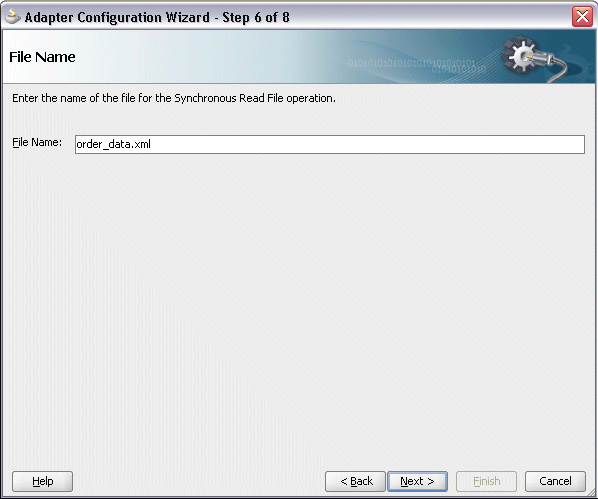
Click Next. The Messages dialog box appears.
-
Select Browse for schema file in front of the URL field. The Type Chooser window is displayed.
-
Click the Import Schema Files button on the top right corner of the Type Chooser window.
-
Enter the schema location for the service. Such as
http://<soa_suite_hostname>:<port>/soa-infra/services/default/<jndi_name>_CONCURRENTPROGRAM_WSHDSNO/WSHDSNO_Service?XSD=APPS_ISG_CP_REQUEST_CP_SUBMIT.xsd.Schema location for your service can be found from the service WSDL URL (for example,
http://<soa_suite_hostname>:<port>/soa-infra/services/default/<jndi_name>_CONCURRENTPROGRAM_WSHDSNO/WSHDSNO_Service?wsdl). -
Select the Copy to Project checkbox and click OK.
The Localize Files window appears. Ensure the Maintain original directory structure for imported files checkbox is selected and click OK.
The Imported Schema folder is automatically added to the Type Chooser window.
-
Expand the Imported Schema folder and select InputParameters Message in the
WSHDSNO_Service_XSD_APPS_ISG_CP_REQUEST_CP_SUBMIT.xsd. Click OK. -
The selected .xsd is displayed as URL, and the InputParameters is selected as Schema Element.
Messages Dialog with Selected Message Schema
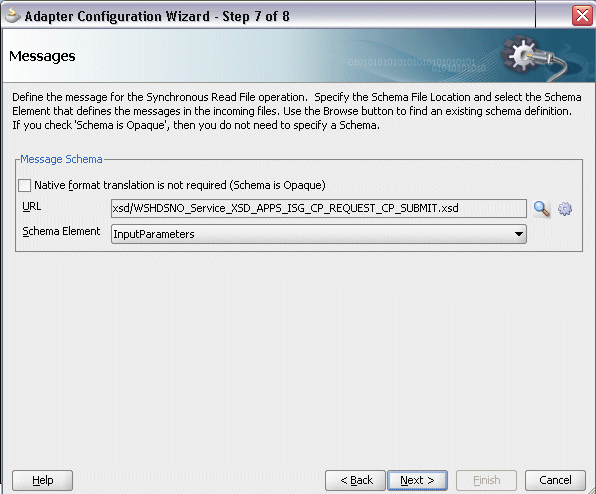
-
-
Click Next and then Finish. The wizard generates the WSDL file corresponding to the partner link. The main Create Partner Link dialog box appears, specifying the new WSDL file
ReadOrder.wsdl.Click Apply and then OK to complete the configuration and create the partner link with the required WSDL settings for the File Adapter Service.
The
ReadOrderPartner Link appears in the BPEL process diagram.
Adding Invoke Activities
This step is to configure two Invoke activities in order to:
-
Read order details passed from the first Assign activity through the
ReadOrderpartner link for File Adapter. -
Send the order header and line details received from the Assign activities and generate an outbound shipment notice (DSNO) through the
Shipment_Noticepartner link.
To add an Invoke activity for ReadOrder Partner Link:
-
In Oracle JDeveloper, expand the BPEL Constructs from the Component Palette. Drag and drop the Invoke activity from the Component Palette into the center swim lane of the process diagram, between the receiveInput and replyOutput activities.
-
Link the Invoke activity to the
ReadOrderservice. The Invoke activity will send order data to the partner link. The Edit Invoke dialog box appears.Edit Invoke Dialog
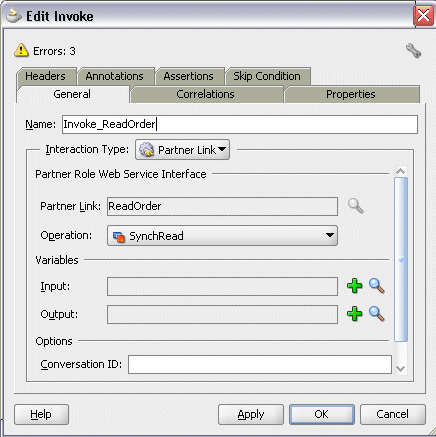
-
Enter a name for the Invoke activity, and then click the Create icon next to the Input Variable field to create a new variable. The Create Variable dialog box appears.
Create Variable Dialog for Input Variable
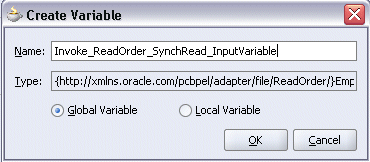
-
Enter a name for the variable. You can also accept the default name. Ensure the Global Variable radio button is selected and click OK.
-
Click the Create icon next to the Output Variable field.
Enter a name for the output variable. You can also accept the default name. Ensure the Global Variable radio button is selected and click OK.
Create Variable Dialog for Output Variable
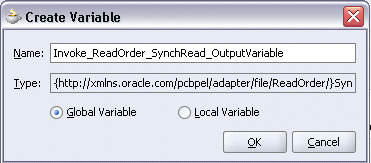
-
Click Apply and then OK in the Edit Invoke dialog box to finish configuring the Invoke activity.
The Invoke activity appears in the process diagram.
To add the second Invoke activity for Shipment_Notice Partner Link:
-
In Oracle JDeveloper, expand the BPEL Constructs from the Component Palette. Drag and drop the second Invoke activity from the Component Palette into the center swim lane of the process diagram, after the Invoke and replyOutput activities.
-
Link the Invoke activity to the
Shipment_Noticeservice. The Invoke activity will send event data to the partner link. The Edit Invoke dialog box appears. -
Enter a name for the Invoke activity such as 'Invoke_ShipmentNotice'. Select input and output global variables as described in the first Invoke activity creation procedure.
Click Apply and then OK in the Edit Invoke dialog box to finish configuring the Invoke activity.
The second Invoke activity appears in the process diagram.
Adding Assign Activities
This step is to configure three Assign activities:
-
To pass the application context for SOAHeader in the invocation of the DSNO concurrent program service.
-
To pass the order details from the output of the Synchronous Read - File Adapter service to the input of the DSNO creation through the Invoke_ShipmentNotice Invoke activity.
-
To set the SOAP response to output.
Assigning SOAHeader Parameters:
To add the first Assign activity to pass SOAHeader variables used in the invocation of the DSNO concurrent program service:
-
In Oracle JDeveloper, expand the BPEL Constructs from the Component Palette. Drag and drop the Assign activity into the center swim lane of the process diagram between the two Invoke activities you just created earlier.
-
Double-click the Assign activity to access the Edit Assign dialog box.
-
Enter 'SOAHeader' as the Assign name in the Edit Assign dialog box. Click OK.
-
Select the Copy Rules tab and expand the target trees:
-
Click the Expression icon to invoke the Expression Builder dialog.
Enter 'ORDER_MGMT_SUPER_USER' in the Expression box. Click OK. The Expression icon with the expression value ('ORDER_MGMT_SUPER_USER') appears in the center of the Edit Assign dialog, between the From and To navigation tree nodes.
-
In the To navigation tree, navigate to Variables > Process > Variables > Invoke_Shipment_Notice_WSHDSNO_InputVariable >header > ns2:SOAHeader and select ns2:Responsibility.
Drag the Expression icon to connect to the target node (ns2:Responsibility) that you just identified. This creates a line that connects the source and target nodes. The copy rule is displayed in the From and To sections at the bottom of the Edit Assign dialog box.
-
-
Enter the second pair of parameters by clicking the Expression icon to invoke the Expression Builder dialog.
-
Enter 'ONT' in the Expression box. Click OK. The Expression icon with the expression value ('ONT') appears in the center of the Edit Assign dialog, between the From and To navigation tree nodes.
-
In the To navigation tree, navigate to Variables > Process > Variables > Invoke_Shipment_Notice_WSHDSNO_InputVariable >header > ns2:SOAHeader and select ns2:RespApplication.
Drag the Expression icon to connect to the target node (ns2:RespApplication) that you just identified. This creates a line that connects the source and target nodes. The copy rule is displayed in the From and To sections at the bottom of the Edit Assign dialog box.
-
-
Enter the third pair of parameters by clicking the Expression icon to invoke the Expression Builder dialog.
-
Enter 'STANDARD' in the Expression box. Click OK. The Expression icon with the expression value ('STANDARD') appears in the center of the Edit Assign dialog, between the From and To navigation tree nodes.
-
In the To navigation tree, navigate to Variables > Process > Variables > Invoke_Shipment_Notice_WSHDSNO_InputVariable >header > ns2:SOAHeader and select ns2:SecurityGroup.
Drag the Expression icon to connect to the target node (ns2:SecurityGroup) that you just identified. This creates a line that connects the source and target nodes. The copy rule is displayed in the From and To sections at the bottom of the Edit Assign dialog box.
-
-
Enter the fourth pair of parameters by clicking the Expression icon to invoke the Expression Builder dialog.
-
Enter 'AMERICAN' in the Expression box. Click OK. The Expression icon with the expression value ('AMERICAN') appears in the center of the Edit Assign dialog, between the From and To navigation tree nodes.
-
In the To navigation tree, select type Variable. Navigate to Variables > Process > Variables > Invoke_Shipment_Notice_WSHDSNO_InputVariable >header > ns2:SOAHeader and select ns2:NLSLanguage.
Drag the Expression icon to connect to the target node (ns2:NLSLanguage) that you just identified. This creates a line that connects the source and target nodes. The copy rule is displayed in the From and To sections at the bottom of the Edit Assign dialog box.
-
-
Enter the fifth pair of parameters by clicking the Expression icon to invoke the Expression Builder dialog.
-
Enter '202' in the Expression box. Click OK. The Expression icon with the expression value ('202') appears in the center of the Edit Assign dialog, between the From and To navigation tree nodes.
-
In the To navigation tree, select type Variable. Navigate to Variables > Process > Variables > Invoke_Shipment_Notice_WSHDSNO_InputVariable >header > ns2:SOAHeader and select ns2:Org_Id.
Drag the Expression icon to connect to the target node (ns2:NLSLanguage) that you just identified. This creates a line that connects the source and target nodes. The copy rule is displayed in the From and To sections at the bottom of the Edit Assign dialog box.
-
-
The Edit Assign dialog box appears.
Click Apply and then OK to complete the configuration of the Assign activity.
To add the second Assign activity to set order details to the Invoke_ShipmentNotice Invoke activity:
-
In Oracle JDeveloper, expand the BPEL Constructs from the Component Palette. Drag and drop the Assign activity into the center swim lane of the process diagram, between the Assign and Invoke activities.
-
Double-click the Assign activity to access the Edit Assign dialog box.
-
Click the General tab to enter the name for the Assign activity, such as 'SetOrderDetails'.
-
Select the Copy Rules tab and expand the source and target trees:
-
In the From navigation tree, navigate to Variables > Process > Variables > InvokeReadOrder_SynchRead_OutputVariable > body > InputParameters and select ns1:InputParameters.
-
In the To navigation tree, navigate to Variables > Process > Variables > InvokeShipmentNotice_WSHDSNO_InputVariable > body and select ns1:InputParameters.
Drag the source node (ns1:InputParameters) to connect to the target node (ns1:InputParameters) that you just identified. This creates a line that connects the source and target nodes. The copy rule is displayed in the From and To sections at the bottom of the Edit Assign dialog box.
-
-
The Edit Assign dialog box appears.
Click Apply and then OK to complete the configuration of the Assign activity.
To add the third Assign activity to set SOAP response to output:
-
Add the third Assign activity by dragging and dropping the Assign activity from the BPEL Constracts section of the Component Palette into the center swim lane of the process diagram, between the Invoke and the Reply activities.
-
Repeat Step 2 to Step 3 described in creating the first Assign activity to add the third Assign activity called 'SetCPdetails'.
-
Select the Copy Rules tab and expand the target trees:
-
In the From navigation tree, navigate to Variables > Process > Variables > InvokeShipmentNotice_WSHDSNO_OutputVariable and select body.
-
In the To navigation tree, navigate to Variables > Process > Variables > OutputVariable and select payload.
Drag the source node (body) to connect to the target node (payload) that you just identified. This creates a line that connects the source and target nodes. The copy rule is displayed in the From and To sections at the bottom of the Edit Assign dialog box.
-
-
Click Apply and then OK to complete the configuration of the Assign activity.
Configuring Web Service Policies
Use the following steps to add a security policy at design time:
-
Navigate to SOA Content > Business Rules > composite.xml. Right click on the
Shipment_Noticeservice and select "Configure WS Policies" from the drop-down list. -
The Configure SOA WS Policies dialog appears.
In the Security section, click the Add icon (+). The Select Server Security Policies dialog appears.
Select Server Security Policies Dialog
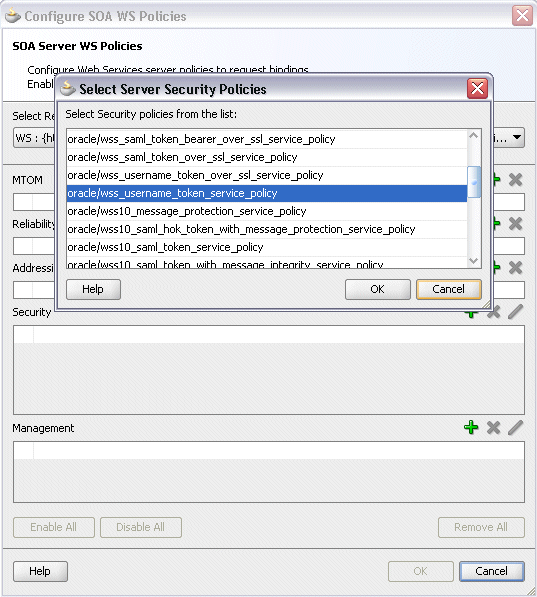
Select 'oracle/wss_username_token_service_policy' and click OK.
The attached security policy is shown in the Security section.
A lock icon appears in the
Shipment_Noticeservice of thecomposite.xmlindicating that a security policy has been successfully attached. -
From the navigation menu, select View > Property Inspector to display the Property Inspector window for
Shipment_Noticeservice component.In the Properties section, click the Add icon (+) for binding properties. The Create Property dialog appears.
Enter '
oracle.webservices.auth.username' in the Name field and enter 'operations' as the value.Click OK.
-
Use the same approach by clicking the Add icon (+) again in the Properties section for binding properties. Enter '
oracle.webservices.auth.password' in the Name field. Enter the associated password for user 'operations' in the Value field.Click OK.
Both selected property names and values appear in the Properties section.
Click the Source tab of
composite.xmland notice that theoracle.webservices.auth.usernameandoracle.webservices.auth.passwordproperty names and the associated values are added to theShipment_Noticereference.Composite.xml File with Property Information

Deploying and Testing the SOA Composite with BPEL Process at Runtime
To invoke the synchronous Departure Shipment Notice Outbound WSHDSNO service from the BPEL client contained in the SOA composite, the SOA composite needs to be deployed to the Oracle WebLogic managed server. This can be achieved using Oracle JDeveloper. Once the composite is deployed, it can be tested from the Oracle Enterprise Manager Fusion Middleware Control Console.
Prerequisites
Before deploying the SOA composite with BPEL process using Oracle JDeveloper, you must have established the connectivity between the design-time environment and the runtime server. For information on how to configure the necessary server connection, see Configuring Server Connection.
Note: If a local instance of the Oracle WebLogic Server is used, start the WebLogic Server by selecting Run > Start Server Instance from Oracle JDeveloper. Once the WebLogic Admin Server "DefaultServer" instance is successfully started, the <Server started in Running mode> and DefaultServer started message in the Running:DefaultServer and Messages logs should appear.
Perform the following runtime tasks:
Deploying the SOA Composite Application with BPEL Process
You must deploy the SOA composite application with BPEL process (ShipNotice.bpel) that you created earlier before you can run it.
To deploy the SOA composite application BPEL process:
-
In the Applications Navigator of Oracle JDeveloper, select the ShipNotice project.
-
Right-click the project and select Deploy > [project name] > [serverConnection] from the menu.
For example, you can select Deploy > ShipNotice > SOAServer to deploy the process if you have the connection appropriately.
Note: If this is the first time to set up the server connection, then the Deployment Action dialog appears. Select 'Deploy to Application Server' and click Next.
In the Deploy Configuration dialog, ensure the following information is selected before clicking Next to add a new application server:
-
New Revision ID: 1.0
-
Mark composite revision as default: Select this checkbox.
-
Overwrite any existing composites with the same revision ID: Select this checkbox.
The steps to create a new Oracle WebLogic Server connection from Oracle JDeveloper are covered in Configuring Server Connection.
-
-
In the Select Server dialog, select 'soa-server1' that you have established the server connection earlier. Click Next.
-
In the SOA Servers dialog, accept the default target SOA Server ('soa-server1') selection.
Click Next and Finish.
-
If you are deploying the composite for the first time from your Oracle JDeveloper session, the Authorization Request window appears. Enter username and password information specified during Oracle SOA Suite installation. Click OK.
-
Deployment processing starts. Monitor deployment process and check for successful compilation in the SOA - Log window.
Verify that the deployment is successful in the Deployment - Log window.
Testing the SOA Composite Application with BPEL Process
Once the BPEL process contained in the SOA composite application has been successfully deployed, you can manage and monitor the process from Oracle Enterprise Manager Fusion Middleware Control Console.
You can also log in to Oracle E-Business Suite to manually initiate the processes and to confirm that the departure shipment notice outbound (DSNO) is generated in the XML file.
For more information about Oracle SOA Suite, see the Oracle Fusion Middleware Administrator's Guide for Oracle SOA Suite.
To test the SOA composite application with BPEL process:
-
Navigate to Oracle Enterprise Manager Fusion Middleware Control Console (
http://<hostname>:<port>/em). The login page appears. -
Enter the username and the password specified during Oracle SOA Suite installation. Click Login to log in to a farm. The composite (ShipNotice) you deployed is displayed in the Applications Navigation tree.
You may need to select an appropriate target instance farm if there are multiple target Oracle Enterprise Manager Fusion Middleware Control Console farms.
-
From the Farm navigation pane, expand the
SOA >soa-infranode in the tree to navigate through the SOA Infrastructure home page and menu to access your deployed SOA composite applications running onsoa-inframanaged server.Click the ShipNotice [1.0] link.
-
Click the Policies tab and notice that the 'oracle/wss_username_token_service_policy' policy you attached to the
Shipment_Noticeservice binding earlier at the design time is now displayed here. -
In the ShipNotice [1.0] home page, click Test.
-
The Test Web Service page for initiating an instance appears. You can specify information as XML payload data to use in the Input Arguments section.
Note: If the WS-Security credentials are not entered at design time, you can enter the credentials at runtime by selecting the WSS Username Token option in the Security section at the top of the Request tab. Enter 'operations' in the Username field and the associated password in the Password field.
Click Test Web Service to initiate the process.
The test results appear in the Response tab upon completion.
-
Click your BPEL service component instance link (such as ShipNotice) to display the Instances page where you can view the invocation details of the BPEL activities in the Audit Trail tab.
Click the Flow tab to check the BPEL process flow diagram. Click an activity of the process diagram to view the activity details and flow of the payload through the process.
-
Double-click the Invoke_ShipmentNotice icon from the process flow chart and click the View XML document link to open the XML file. This file records the Request ID that is returned for the transaction.
Verifying Records in Oracle E-Business Suite
Before verifying the records in Oracle E-Business Suite, you must first ensure that the concurrent request is completed successfully.
-
Log in to Oracle E-Business Suite as a user who has the System Administrator responsibility. Select View > Requests to open the Find Requests window.
-
Search for the concurrent request by entering the Request Id that you got from the audit trail and then click Find.
-
The request details page is displayed. Check the Phase and Status of the request to see if the Status of the request is
Complete.
Once the concurrent request has been completed successfully, you can validate it in Oracle E-Business Suite.
Since DSNO (departure shipment notice outbound) is an outbound XML message, relevant XML Gateway setup tasks must be configured appropriately in order for the shipment notice to be delivered to the right recipient.
See the Oracle XML Gateway User's Guide for details.
You can validate if the ship-to address, purchase order, and requested ship date information in the DSNO XML file corresponds with the information in your sales order.